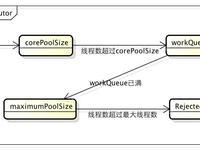一、概述
1、ThreadPoolExecutor作为java.util.concurrent包对外提供基础实现,以内部线程池的形式对外提供管理任务执行,线程调度,线程池管理等等服务;
2、Executors方法提供的线程服务,都是通过参数设置来实现不同的线程池机制。
3、先来了解其线程池管理的机制,有助于正确使用,避免错误使用导致严重故障。同时可以根据自己的需求实现自己的线程池
二、核心构造方法讲解
下面是ThreadPoolExecutor最核心的构造方法
class="java">public ThreadPoolExecutor(int corePoolSize,
int maximumPoolSize,
long keepAliveTime,
TimeUnit unit,
BlockingQueue<Runnable> workQueue,
ThreadFactory threadFactory,
RejectedExecutionHandler handler) {
if (corePoolSize < 0 ||
maximumPoolSize <= 0 ||
maximumPoolSize < corePoolSize ||
keepAliveTime < 0)
throw new IllegalArgumentException();
if (workQueue == null || threadFactory == null || handler == null)
throw new NullPointerException();
this.corePoolSize = corePoolSize;
this.maximumPoolSize = maximumPoolSize;
this.workQueue = workQueue;
this.keepAliveTime = unit.toNanos(keepAliveTime);
this.threadFactory = threadFactory;
this.handler = handler;
}
构造方法参数讲解
参数名作用corePoolSize核心线程池大小maximumPoolSize最大线程池大小keepAliveTime线程池中超过corePoolSize数目的空闲线程最大存活时间;可以allowCoreThreadTimeOut(true)使得核心线程有效时间TimeUnitkeepAliveTime时间单位workQueue阻塞任务队列threadFactory新建线程工厂RejectedExecutionHandler当提交任务数超过maxmumPoolSize+workQueue之和时,任务会交给RejectedExecutionHandler来处理
重点讲解:
其中比较容易让人误解的是:corePoolSize,maximumPoolSize,workQueue之间关系。
1.当线程池小于corePoolSize时,新提交任务将创建一个新线程执行任务,即使此时线程池中存在空闲线程。
2.当线程池达到corePoolSize时,新提交任务将被放入workQueue中,等待线程池中任务调度执行
3.当workQueue已满,且maximumPoolSize>corePoolSize时,新提交任务会创建新线程执行任务
4.当提交任务数超过maximumPoolSize时,新提交任务由RejectedExecutionHandler处理
5.当线程池中超过corePoolSize线程,空闲时间达到keepAliveTime时,关闭空闲线程
6.当设置allowCoreThreadTimeOut(true)时,线程池中corePoolSize线程空闲时间达到keepAliveTime也将关闭
线程管理机制图示:
 三、Executors提供的线程池配置方案
1、构造一个固定线程数目的线程池,配置的corePoolSize与maximumPoolSize大小相同,同时使用了一个无界LinkedBlockingQueue存放阻塞任务,因此多余的任务将存在再阻塞队列,不会由RejectedExecutionHandler处理
三、Executors提供的线程池配置方案
1、构造一个固定线程数目的线程池,配置的corePoolSize与maximumPoolSize大小相同,同时使用了一个无界LinkedBlockingQueue存放阻塞任务,因此多余的任务将存在再阻塞队列,不会由RejectedExecutionHandler处理
public static ExecutorService newFixedThreadPool(int nThreads) {
return new ThreadPoolExecutor(nThreads, nThreads,
0L, TimeUnit.MILLISECONDS,
new LinkedBlockingQueue<Runnable>());
}
2、构造一个缓冲功能的线程池,配置corePoolSize=0,maximumPoolSize=Integer.MAX_VALUE,keepAliveTime=60s,以及一个无容量的阻塞队列 SynchronousQueue,因此任务提交之后,将会创建新的线程执行;线程空闲超过60s将会销毁
public static ExecutorService newCachedThreadPool() {
return new ThreadPoolExecutor(0, Integer.MAX_VALUE,
60L, TimeUnit.SECONDS,
new SynchronousQueue<Runnable>());
}
3、构造一个只支持一个线程的线程池,配置corePoolSize=maximumPoolSize=1,无界阻塞队列LinkedBlockingQueue;保证任务由一个线程串行执行
public static ExecutorService newSingleThreadExecutor() {
return new FinalizableDelegatedExecutorService
(new ThreadPoolExecutor(1, 1,
0L, TimeUnit.MILLISECONDS,
new LinkedBlockingQueue<Runnable>()));
}
4、构造有定时功能的线程池,配置corePoolSize,无界延迟阻塞队列DelayedWorkQueue;有意思的是:maximumPoolSize=Integer.MAX_VALUE,由于DelayedWorkQueue是无界队列,所以这个值是没有意义的
public static ScheduledExecutorService newScheduledThreadPool(int corePoolSize) {
return new ScheduledThreadPoolExecutor(corePoolSize);
}
public static ScheduledExecutorService newScheduledThreadPool(
int corePoolSize, ThreadFactory threadFactory) {
return new ScheduledThreadPoolExecutor(corePoolSize, threadFactory);
}
public ScheduledThreadPoolExecutor(int corePoolSize,
ThreadFactory threadFactory) {
super(corePoolSize, Integer.MAX_VALUE, 0, TimeUnit.NANOSECONDS,
new DelayedWorkQueue(), threadFactory);
}
四、定制属于自己的线程池

- 大小: 33.1 KB
